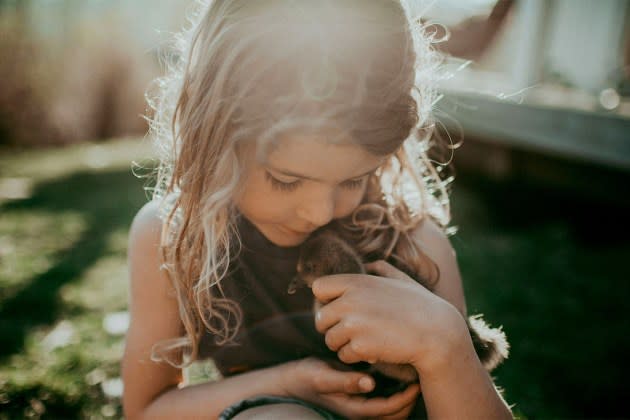‘A New Kind of Wilderness’ Review: A Small but Stirring Portrait of a Family in Transition

Silje Evensmo Jacobsen’s A New Kind of Wilderness is one of the “littlest” documentaries I’ve ever seen.
It’s a film without a clear hook. Any enticing description would be misleading.
More from The Hollywood Reporter
At the same time, it’s a reminder that you don’t need sensationalism to deliver something that’s honest and emotionally resonant. I spent 40 minutes watching A New Kind of Wilderness and wondering what the documentary was supposed to be, and the last 44 minutes being simply and persuasively moved by this story of a family facing tragedy and trying to hang together while seeking a new normal.
Maria and Nik chose a very unusual life for themselves and their four children — Ronja, from her previous relationship, Freja, Falk and Ulv. They live sustainably on a small farm in rural Norway. They’re a long way from civilization, the kids are entirely home-schooled — speaking both Norwegian and English (Nik is British) — and the tight family unit has no evident contact with outside friends or family.
Then Maria, who chronicled the family’s life project for a blog and whose photography was the family’s only source of income, gets cancer and dies. Suddenly the Paynes can’t afford to remain on the farm, Ronja goes to live with her father, and the rest of the family moves to a more populated area. This forces them to reevaluate how they can hold on to some of the values that Maria cherished, while adapting and grieving and loving in their new reality.
Sounds a bit like an unscripted version of Captain Fantastic, which earned Viggo Mortensen an Oscar nomination. Or maybe like a Norwegian The Wolfpack?
It’s not.
The Paynes are a little strange, but in a hippie-dippie, loosely eccentric kind of way, not a “Modern society is on the verge of collapse and we must move to the woods to wait out the apocalypse” kind of way. Sure, they don’t have a TV, and the guys — in case you aren’t familiar with Scandinavian names, Falk and Ulv are boys — are allergic to haircuts, but there’s no overt hostility to modernity.
And it isn’t like, in the aftermath of Maria’s death, the Paynes pack up their wagon and take up residence in downtown Oslo. They hop in the car and, somewhat reluctantly, head into a town. The kids have to go to school, but it’s a school that’s so chill that the teachers are perfectly fine with the little Paynes continuing to be home-schooled a few days a week.
It’s not really a fish-out-of-water story, just the tale of fish who move from one body of water to another.
For a while, I waited for an edgier “Sundance documentary” to break out. Would Nik be wrongfully accused of murder, or would we discover he had another family somewhere? Was there a dark secret to explain why Ronja was apparently estranged from the other Paynes?
No. A New Kind of Wilderness is not that sort of documentary. What it feels like, more than anything, is an old-fashioned WB show, where the characters face light adversity with a brave face, laugh a little, cry a little, and generate some warm fuzzies. It’s Everwood, only without that show’s regular weekly doses of topicality. In lieu of hot-button issues, the problems in the documentary are intimate and simple: Ronja isn’t harboring a dark secret, she’s just a teenage girl who misses her mother. Nik wants to respect his wife’s wishes to raise the kids in Norway, but he misses his family in England. Freja is afraid to go to school … because she doesn’t like the idea of having to raise her hand to ask questions.
See what I mean about this being a little film? Yet it works, because the insecurities and pain and reservoirs of affection are more instantly relatable than if Jacobsen had forced a big narrative structure around the Paynes and their story. Instead, A New Kind of Wilderness has a loose and relaxed approach to time, sometimes jumping months ahead without acknowledgment other than a changed haircut or the background weather. The Paynes are finding their way through life, and Jacobsen just lets them.
Jacobsen benefits tremendously from a previous relationship with the family — she had been a fan of Maria’s blog and had documented their lifestyle for a decade before the events of the film — and from the documenting that Maria had done over the years. The kids have a comfort with Jacobsen and with the idea of living in front of a rolling camera. Though Ulv and Falk remain too young to always be valuable pieces of the documentary, they occasionally have unforced insights into their changed lives, while Ronja and Freja’s shifting relationship and their shared need for a sisterly bond is the core of the film.
Maria’s own footage has a dreamlike quality that Jacobsen and her small team of cinematographers attempt to echo, but not reproduce. There was the life that the Paynes lived before and the life they’re living now, one that doesn’t lack for quiet beauty, though it has rough moments, including a moment of cattle butchery that’s graphic and brutal.
The ideal life in A New Kind of Wilderness is one of quiet contentment, and that’s the level on which I found myself appreciating the documentary by the end. Go in expecting that, rather than any extremes, and it might be even easier to come away with affection well beyond the film’s tiny scale.
Best of The Hollywood Reporter

 Yahoo News
Yahoo News 